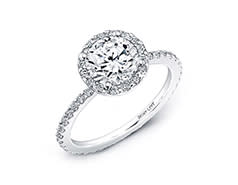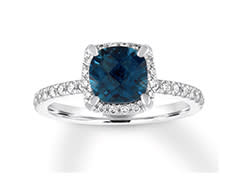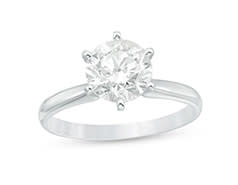Everything You Need to Know About the 4 Cs of Diamonds

Shopping for an engagement ring can be overwhelming—kinda like approaching your now soul mate at that dingy corner bar where you first met. But fear not, because a little bit of knowledge goes a long way. The first step to feeling more confident in your search for the perfect sparkler begins with a brushup on the 4 Cs of diamonds, because understanding how to manipulate each component is how you’ll get the most bling for your buck.
What are the 4 Cs?
The 4 Cs look at a diamond through four dimensions:
1. Cut
2. Color
3. Clarity
4. Carat
Established by the Gemological Institute of America (GIA), the 4 Cs are now a globally accepted grading system that determines the price and quality of a diamond. The 4 Cs are graded on a scale, meaning there is no definitive good or bad diamond, no “perfect” set of specs you should ever feel pressured to pine after. What matters more than any color grade is what you think of the stone in its natural state. A diamond with features at the top of the spectrum is no more beautiful than one that falls a bit lower (though it will most certainly cost more).
According to Stephanie Gottlieb, a fine jewelry designer in NYC (with an Instagram feed to die for), this is one of the most common misconceptions people have about diamonds. “A lot of buyers believe they need something of super high quality to have a beautiful diamond. Most women I know would prefer to have something that looks beautiful to the naked eye but is a hair less than perfect, with the trade-off being a larger carat weight.” It all boils down to what you and your partner want in an engagement ring. After all, perfection is in the eye of the beholder, no?
To make your ring search a bit less stressful (this should be fun, people!), we’ve broken down everything you need to know about the 4 Cs of diamonds, including expert advice to ease your mind and stretch your dollar. Your ultimate diamond-buying guide awaits. Mazel!
RELATED: 10 Minimalist Engagement Rings That Any Bride Will Love

1. CUT
Though it’s unique to every stone, Gottlieb admits that “cut is generally what affects overall appearance the most.” The cut refers to how well the diamond’s proportions interact with light. Think of it as the sparkle factor. Diamonds with exceptional symmetry and polish will have a more brilliant sparkle than those without. And these interactions are determined by how the diamond was cut from nature. “In an ideally cut stone, the light entering the diamond reflects internally from facet to facet and is reflected back out only through the top of the stone,” Gottlieb explains. This accounts for the brightness (the combination of white light reflecting off the surface and interior), the fire (those beautiful “flares” of color that dance around the stone) and the scintillation (the pattern of light and dark areas as it moves through the light). “If a diamond is cut too shallow or too deep, light leaks out the bottom or the sides, causing the stone to appear dark and dull.”
Within the GIA system, diamond cuts are graded as Excellent, Very Good, Good, Fair and Poor. Though the cut has less of an impact on cost than the other Cs, most reputable jewelers won’t go below the Very Good range. Ultimately, let your eyes be your guide. “Each person will resonate with the different characteristics of a diamond. My favorite tip to tell my clients is this: Dirty up the diamond you’re considering with the oils on your hands. Typically, once a stone is dirty, the shine is dulled, but a well-cut diamond will still sparkle nicely.”

Though often used interchangeably, the cut should not be confused with the “shape” of a diamond. The shape refers to the overall outline of the stone and is at the complete discretion of the lucky lady who gets to wear it. The ten main diamond shapes are round, princess, emerald, asscher, marquis, radiant, oval, pear, heart and cushion.
RELATED: These Are the Most Popular Engagement Ring Styles in Every U.S. Region

2. COLOR
Contrary to popular belief, not all diamonds are colorless. In fact, truly colorless diamonds are extremely rare. A diamond’s color grade actually refers to the lack of color and is determined by comparing each stone to a master set. The GIA system grades color on a scale of D, meaning completely colorless, to Z, meaning the presence of color in the form of a light yellow hue. Diamonds in the D to F range are considered colorless and will, therefore, cost the most. Diamonds in the G to J range are considered near colorless and are often considerably less expensive.
Freaked out by the word yellow and unsure where to start? “Color is the most noticeable factor of a diamond (aside from size), so most untrained eyes will be able to detect traces of obvious yellow,” Gottlieb explains. “That said, you do not need to purchase a colorless diamond (D to F) to have something that will appear white. There is a lot of value to be found in the near colorless range (G to J).” Even then, “you won’t be able to notice a difference without jumping two color grades. If all other factors are the same and you’re deciding between an H and an I, the lower color grade might be worth the money saved.”
Specific color grades can also be more noticeable across the various diamond shapes. Emerald, asscher and round typically conceal color, so you can go lower on the scale without any noticeable change. Pear, princess, oval, cushion, radiant, marquis and heart, however, will require a higher quality grade to avoid any unwanted hints of yellow.

3. CLARITY
A diamond’s clarity refers to the amount of natural imperfections, known as inclusions, present in the interior of the diamond. The GIA system grades clarity based on the number, size, and location of these inclusions in relation to their visibility with the unaided eye. Shiny-rock reality check? Inclusions occur in almost every diamond on the market (they are created under years of pressure and heat, after all). Though most inclusions tend to be microscopic, some diamonds with grades nearing the lower half of the scale can have inclusions visible to the naked eye. Clarity ranges from Flawless and Internally Flawless (F and IF) to Included (I3), but a stone doesn’t have to be considered Flawless to look inclusion-free. Your perfect diamond could be Very Slightly Included (VS2) or Slightly Included (SI1) and still appear beautiful.
When considering clarity, Gottlieb warns against falling into the “Flawless” trap. “I always advise buyers to choose an ‘eye clean’ stone, which means that, to the naked eye, you cannot see any imperfections. These stones usually fall in the VS1, VS2, SI1 or SI2 range. One should also always keep in mind that depending on the location of an inclusion, once the diamond is mounted in a ring, it is very possible that any imperfection will be hidden by the setting.”
In addition, this component will matter more (or less) based on the kind of cut you choose. “Clarity is the first place you can compromise on a brilliant-cut stone (like a round diamond with multiple angles) because the faceting hides most imperfections very well.” All you’ll see is shine, shine and more shine. “That said, with a step-cut stone (like an emerald diamond with square angles that sit parallel to each other), clarity should be a top priority.” Either way, “no two stones will be exactly alike, so finding the right one for you is key.” Striking a balance between, cut, color and clarity will help you stay in line and on budget for your fourth C goals: carat weight.

4. CARAT
Ah, the carat weight. The final C you’ve probably heard about most and arbitrarily threw around while daydreaming with your friends. I mean, it has to be four carats, right? In reality, carat is a measurement of how much the diamond weighs, and each carat is divided into 100 “points”––meaning a 25-point diamond weighs 0.25 carats. Where carat comes into play most is with cost. A naturally large diamond is considered a rarity, so the larger the carat size, the higher the price tag.
Keep in mind, “carat is a reflection of the weight of the diamond, not the visible appearance in size.” Gottlieb suggests taking into account a stone’s physical size before deciding on carat weight. “You can often find a stone with measurements larger than the carat weight would suggest.” Set three different diamonds with the same carat weight side by side and they’ll all have slightly different sizes, guaranteed. “Also, the sparkle of a well-cut diamond can make it appear larger than the carat weight would suggest. This is where you can find value!”
Research and infographics aside, shopping for an engagement ring can be an overwhelming experience, even with a complete understanding of the 4 Cs of diamonds. As a buyer, how can you feel confident that you’re making the right decision and getting what you pay for? “Diamond pricing has become pretty transparent due to online retailers,” Gottlieb explains. “I would say that if a price sounds too cheap, there’s usually a reason.” To avoid any chance of second-guessing, find a jeweler who’s equipped with the knowledge and ability to educate and is willing to take the time to guide you through the process. Also, heed the advice of our seasoned expert: “Definitely only go for a GIA certified diamond!”
Happy hunting, lovebirds!
RELATED: Quiz: What Engagement Ring Should You Really Have?
Shop Engagement Rings Now:

Pavé Halo Round Engagement Ring ($2,995 for setting)

Diamond Trinity Engagement Ring ($10,036)

Stephanie Gottlieb Classic Pave Engagement Ring (Price upon request)

Neil Lane Premiere Diamond Engagement Ring ($9,500)

Blue Topaz Engagement Ring ($1,300)

Diamond Solitaire Engagement Ring ($12,500)

Moritz Glik Gold, Sapphire and Diamond Ring ($3,095)
PureWow may receive a portion of sales from products purchased from this article, which was created independently from PureWow's editorial and sales departments.

